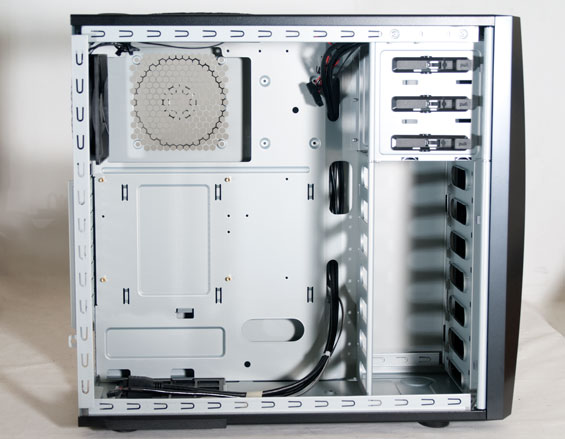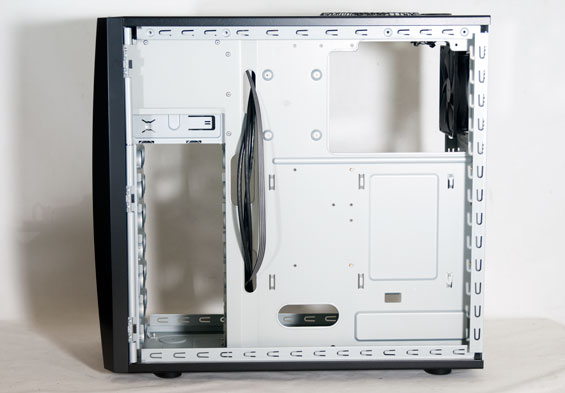Antec Three Hundred Two: Stay Cool, Budget Enthusiasts
by Dustin Sklavos on January 24, 2012 7:00 AM EST- Posted in
- Cases/Cooling/PSUs
- Antec
- mid-tower
In and Around the Antec Three Hundred Two
As is typical of sub-$100 cases, the Antec Three Hundred Two isn't particularly flashy. We can be thankful it's not gaudy, but the basic plastic finish and extensive ventilation in the front doesn't do a lot for making the Three Hundred Two much of an eye-catcher either.
The outer shell of the Three Hundred Two really is pretty basic and bog standard. Antec employs a black plastic front bezel with ventilated 5.25" drive bay shields and then a massive amount of ventilation in front of the internal drive bays (note that a pair of 120mm fans can also be mounted here). In place of USB 2.0, however, Antec has included a pair of USB 3.0 ports at the top front of the case next to the audio jacks and power and reset buttons. The USB 3.0 ports are controlled off of an internal header, as has become standard with new enclosures over the past few months.
When we get to the side panels, the left side is business as usual, with a single ventilated fan mount for a 120mm intake fan to blow across the expansion cards. The right side, on the other hand, tries something a little different: there's a 120mm fan mount placed directly below the processor socket, behind the cutout in the motherboard tray. I've seen Antec and SilverStone experiment with this, but I'm still waiting for one of them to actually decide it's important enough to mount a fan there in the stock configuration.
The rest of the exterior is more of the same routine. There's a 140mm exhaust fan in the top of the case, and two rubber-grommeted holes for routing liquid cooling tubes. The back features a 120mm exhaust fan as well, but everything's where you'd expect it to be. Can someone explain to me who still uses these liquid cooling holes, especially when even the highest end rigs I've seen from boutiques don't have any use for them? They're included in nearly every case I review as a matter of course, but in a $79 case I'm just not sure what purpose they serve.

When you do remove the thumbscrews from the side panels and pop the Three Hundred Two open, though, you see a more refined build that's in line with modern case design. In an effort to both maximize case width as well as ensure clean cabling, Antec uses a lateral drive cage and then shifts the motherboard tray away from the side a bit to allow for cables to be routed behind it. The side panels are also hinged instead of sliding into notches, making the enclosure easier to open and close.

Antec also supplies a surprisingly effective toolless 5.25" drive locking mechanism as well as decent routing holes in the motherboard tray and a large opening in the tray for mounting cooler backplates, a development prevalent in the industry as a result of Intel's staunch refusal to actually fix their heatsink mounting system. [Ed: Die, push pins, die!]
Ultimately the Three Hundred Two's build and design are fairly straightforward, but it's nice to see more and more advances in case design trickling down like this. This enclosure was clearly designed by people with some sense of what enthusiasts want and require, and they did it all without pushing the price too high.
















50 Comments
View All Comments
TerdFerguson - Tuesday, January 24, 2012 - link
It runs a cable from a USB3 port on the back of the machine.Ammaross - Tuesday, January 24, 2012 - link
"It runs a cable from a USB3 port on the back of the machine."Which, NOTE TO ARTICLE AUTHOR, is an excellent use of those water-cooling holes in the back of cases. :)
DanNeely - Tuesday, January 24, 2012 - link
I'd be more inclined to agree if it wasn't for 20-30% of reviews being 1 or 2 egg wasn't the norm for almost all devices like that. That many unhappy customers means that something is definitely not being done right.bill4 - Wednesday, January 25, 2012 - link
Well why dont you just look at the reviews? There's only 12 of them.It appears most of the poor reviews are whining that it doesnt add a USB 3.0 port it just reroutes from the back. Well DUH. The other thing is people whining that the card readers are only USB 2.0.
Damn, Americans are whiny. If people focused 1/10 their energy on what our govt is doing as they do whining about corporations and products, we might be ok in this country.
justaviking - Tuesday, January 24, 2012 - link
"but anything sound of 40C"I expect you meant to say "anything SOUTH of 40C"
Peroxyde - Tuesday, January 24, 2012 - link
And how about ""anything below 40C"It's shorter and it says exactly what it means. Why use convoluted words which, in addition, could be misleading. South is interpreted differently between habitants in Northern and Southern hemispheres.
justaviking - Tuesday, January 24, 2012 - link
What am I missing? Airflow is airflow.Whether the flow is induced by pushing air in (which must exhaust somewhere), or by sucking air out (which much come in from somewhere), what's the difference? The two critical things are the amount of air that flows over your components, and if that air has already been warmed by flowing over other components first.
It's not like we're significantly pressurizing the case and increasing the air density.
Can someone please educate me?
Arbie - Tuesday, January 24, 2012 - link
With negative pressure - as you note - the air has to come from somewhere. It comes in through every opening in your case, no matter how small. So you get dust all over the internals. This impairs heat transfer from those elements, thus degrading the overall cooling. So you don't want it; simple as that. Why it keeps popping up as a good idea is beyond me.I don't know this case myself but imagine that it can just as well be arranged for a moderate amount of positive pressure, by changing fan directions and possibly adding filters. Or find a better-designed case. Unfortunately, not many manufacturers really think about what we need.
And the situation isn't helped by niggling about $10 more or less in price, as this article does. That's down in the noise level for people designing and building their own PCs. I probably spent $200 experimenting with fans on my last build, until I got everything just right. An extra $50 spent on getting a properly designed case (lots of input fans with removable filters) would be well worth it.
justaviking - Tuesday, January 24, 2012 - link
That makes sense.Dust coming in "randomly" from all over, rather than being forced through filters (which can be cleaned) allows more dust to accumulate on the components.
So it's less about the airflow and more about dust management. I never looked at it that way before.
Thanks.
ImSpartacus - Tuesday, January 24, 2012 - link
Don't forget that a lack of dust management can quickly come to impact long term airflow as well.While a case utilizing negative pressure might still perform adequately in reviews like this one (great review by the way!), long term performance might degrade appreciably if dust isn't regularly cleaned.